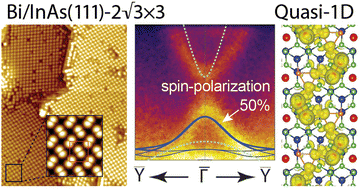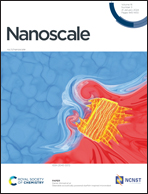Emergence of quasi-1D spin-polarized states in ultrathin Bi films on InAs(111)A for spintronics applications†
Abstract
The discovery, characterization, and control of heavy-fermion low-dimensional materials are central to nanoscience since quantum phenomena acquire an exotic and highly tunable character. In this work, through a variety of comprehensive experimental and theoretical techniques, it was observed and predicted that the synthesis of ultrathin Bi films on the InAs(111)A surface produces quasi-one-dimensional spin-polarized states, providing a platform for the realization of a unique spin-transport regime in the system. Scanning tunneling microscopy and low-energy electron diffraction measurements revealed that the InAs(111)A substrate facilitates the formation of the Bi-dimer phase of 2√3 × 3 periodicity with an admixture of the Bi-bilayer phase under submonolayer Bi deposition. X-ray photoelectron spectroscopy (XPS) measurements have shown the chemical stability of the Bi-induced phases, while spin and angle resolved photoemission spectroscopy (SARPES) observations combined with state-of-the-art DFT calculations have revealed that the electronic spectrum of the Bi-dimer phase holds a quasi-1D hole-like spin-split state at the Fermi level with advanced spin texture, whereas the Bi-bilayer phase demonstrates metallic states with large Rashba spin-splitting. The band structure of the Bi/InAs(111)A interface is discovered to hold great potential as a high-performance spintronics material fabricated in the ultimate two-dimensional limit.



 Please wait while we load your content...
Please wait while we load your content...